Continuing with my sightseeing of the archaeological site Tikal in Guatemala, with a group of a dozen of us I slowly left the Lost World complex and headed for the Plaza of the Seven Temples. I followed the group and the guide, but wherever I looked around I could see some stone structures through the trees and frankly speaking to this very day I actually don’t know what it all was and how much of that there was around, but I think I did see the most important parts. Tikal is an exceptionally important and large site that belongs to the ancient Maya civilisation and it certainly requires a lot of knowledge, as well as the time to visit it all thoroughly and meaningfully.
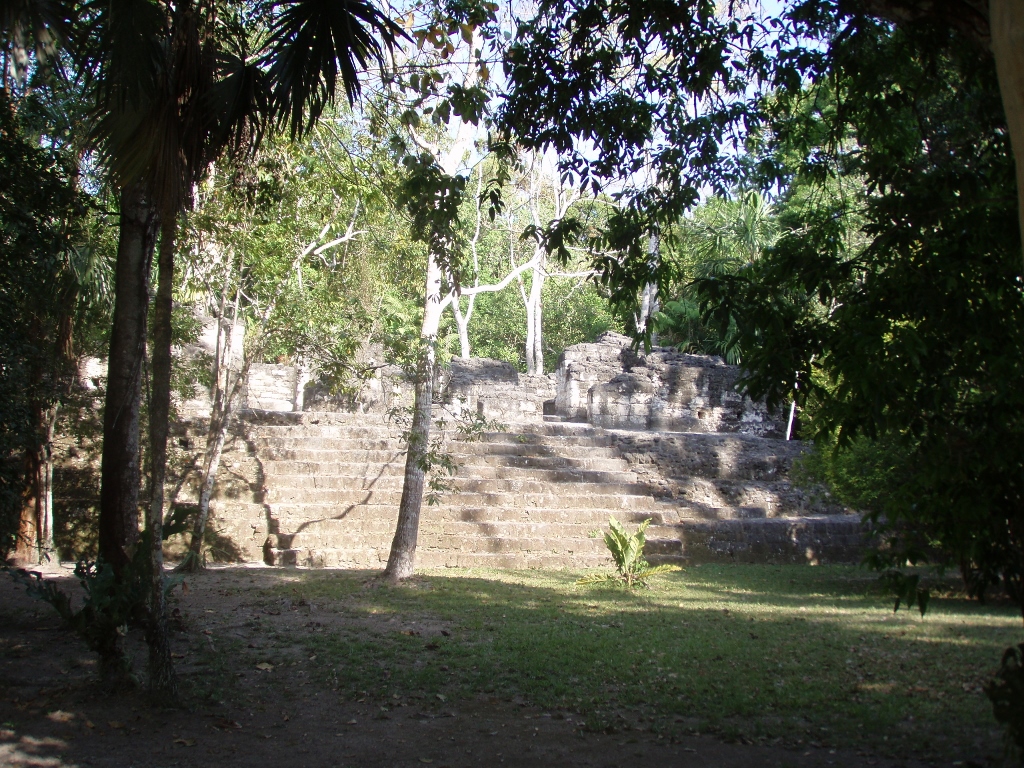 Detail from the archaeological site Tikal
Detail from the archaeological site Tikal
At this point happened something which I laugh about every single time I remember Tikal and my sightseeing. While the guide was mentioning the nearby palaces, he said that there was a lot that was still not known about the Mayas, especially the details that concern the mundane, daily things. In that context, he said that, for instance, it was not known how they had gone about their hygiene and how they had solved the issue concerning their physiological needs. And then and there, in a fraction of a second, arose in me the everlasting nerd and I almost raised my hand and started to cry excitedly: “I know, I know!” In reality the situation simply got better of me and I just jumped into the guide’s explanation saying that in fact there was a room in the palace in Palenque where one could see a proper toilet. (I wrote about that in sequel no. 12 and there is even a photograph thereof, too). I don’t know if this piece of data made any impression on anyone or whether the guide used this later in his future explanations given to visitors, but after my “intervention” I died laughing silently at my own action, while my head blinked with a banner: “There you go, once a nerd, always a nerd!” It is really hard sometimes to shed some of the habits. On the other hand, I simply adore when I have the material to laugh at myself, for I think this is healthy for my ego and consequently for my entire being.
Very soon between the treetops we could see the roof comb of Temple III that is also called the Temple of the Jaguar Priest. It is one of the main temple-pyramids in Tikal. I had already seen its roof comb from the back when I was on the top of Temple IV, but now I could look at it from the side.
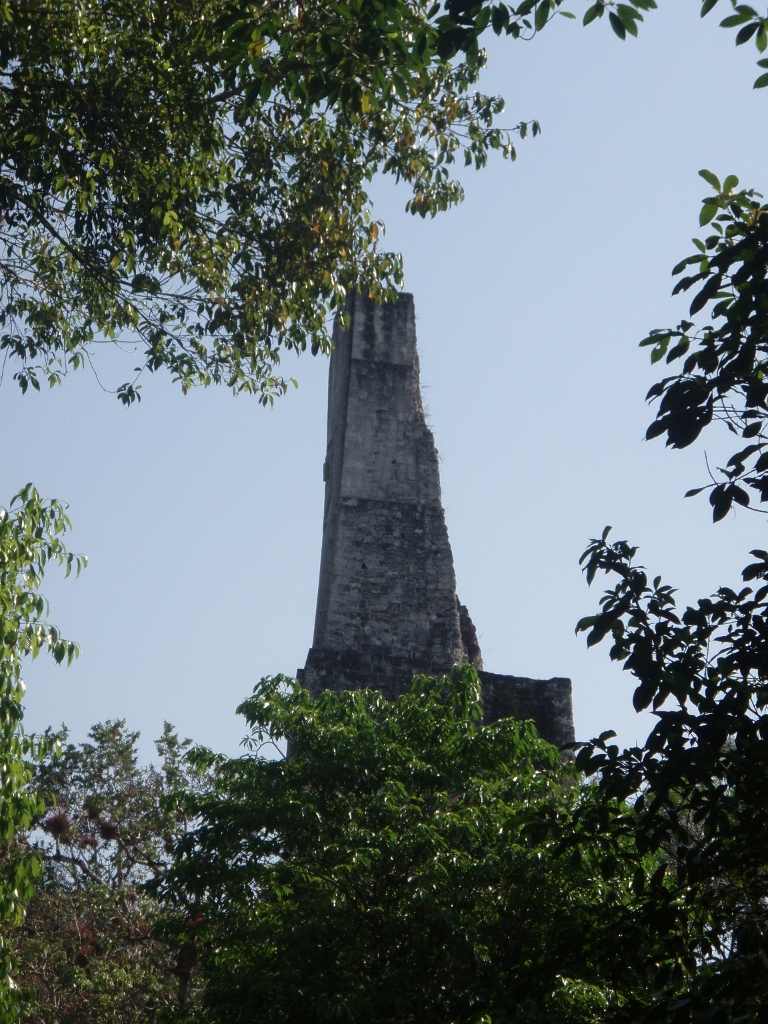 Roof comb of Temple III
Roof comb of Temple III
The temple is 55 metres high and it was built during the Late Classic Period, more accurately in 810. Its construction is linked to a little known ruler Dark Sun and it is presumed that this was his funerary temple. This was also the last temple-pyramid built in Tikal and from here everything just went downhill until the middle of the 10th century when the city was practically abandoned.
Temple III has been only partially restored, with the focus put on the shrine on the top and the roof comb. The pyramid’s body itself has still not been restored and although it is known that there are nine stepped tiers, the temple is closed to public.
Near the place from which I watched the top of Temple III, there is also one of the smaller temples that we walked by. What is interesting about it is that it has steps on the right and left sides in relation to the central section where there is something that is supposed to have been a shrine once, for there is an altar where the offerings could have been put on. On the top of the smallish pyramid, on the flat platform, there are three rooms, with a stone throne clearly visible in the middle one. It is presumed that the priest used to sit there in order to meditate.
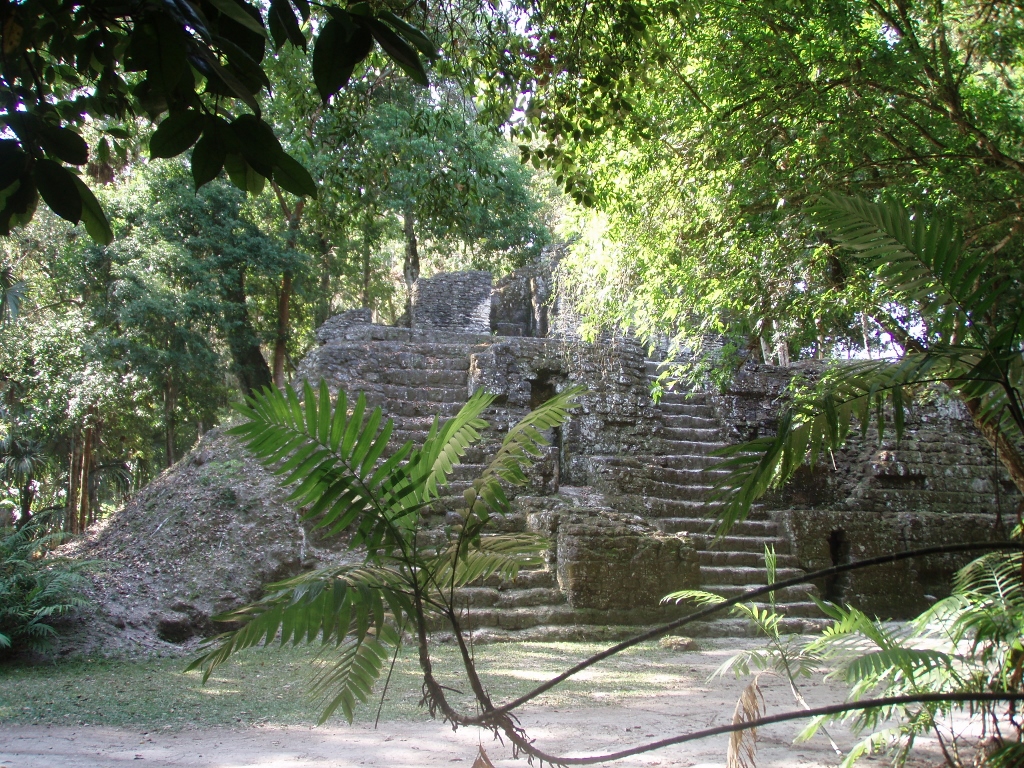 An interesting smaller temple
An interesting smaller temple
Also, to the right from the stairway in the photo above, it is possible to discern something like a narrow passage leading into the pyramid. This is precisely the place where one can see that the Mayas built these pyramids one over the other. When you peek through that passage in the wall, you can see a mask that belongs to the previous pyramid and not the one that is seen on the exterior today.
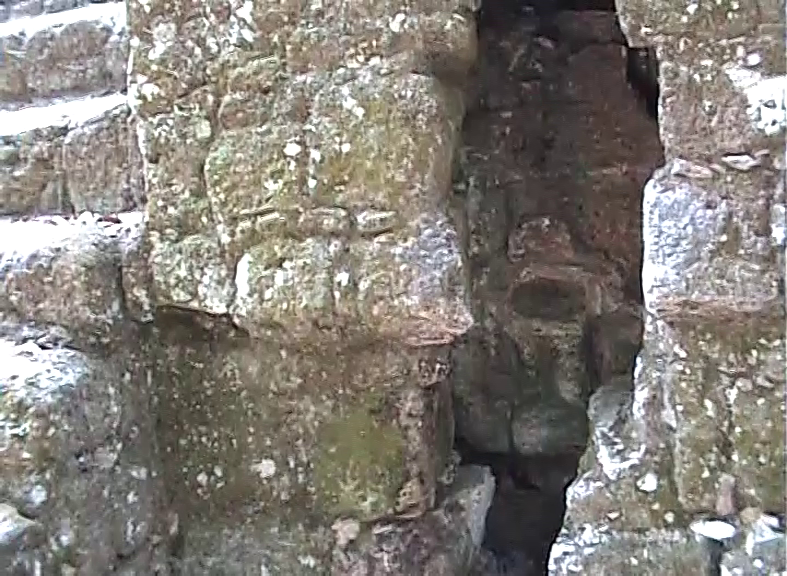 The mask seen inside belongs to the previously built structure
The mask seen inside belongs to the previously built structure
The guide also took this opportunity to explain something else to us here. It is usually said that the Maya did not know the wheel, which actually adds to the impressiveness of their structures. However, as he explained to us, the Maya did not use the wheel, but they knew of the shape, shown by the numerous altars having that form. The theory is that the Mayas actually did not want to use the wheel for in that way they would disrespect their gods of the Sun and the Moon, these being round.
A little farther within the structure of this pyramid it is also possible to see a tunnel that exists between the previous building and the one seen today, but from the outside this appeared to me just like an uninteresting dark and narrow passage.
Following the path that further led to the nearby Plaza of the Seven Temples I wondered what was underneath these piles of soil on the left-hand side in the photo below. Probably some more structures.
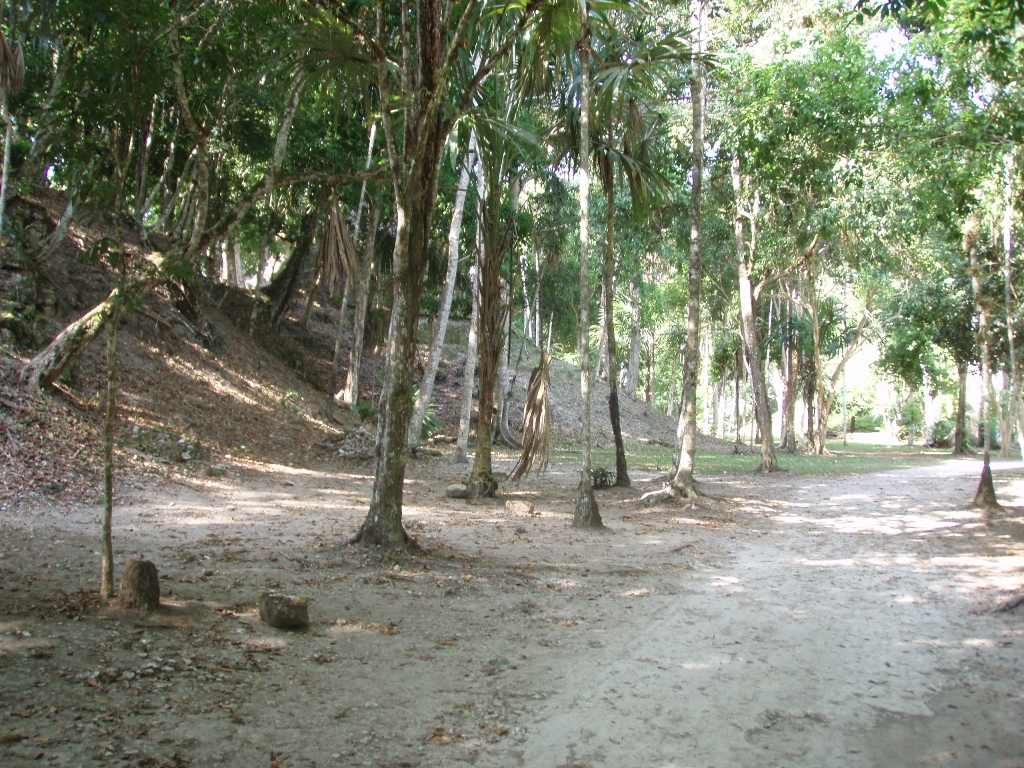 Path in Tikal
Path in Tikal
And then we came to the Plaza of the Seven Temples. On one of its sides there is a place where three ballcourts stand one next to the other. Although these are not big courts, this is a unique example in all of Mesoamerica. In the following photo made from a video recording it is not possible to discern a court quite clearly, primarily because of the lush vegetation and shadows, but the passage straight ahead is a part of the court on the left and right sides of which there are small mounds behind which in parallel there are two more courts, one on each side. When the visitor is there on the spot, the three ballcourts can be seen well – there is a mound, then the flat section, another mound, another court, the mound again, the third court and one more mound.
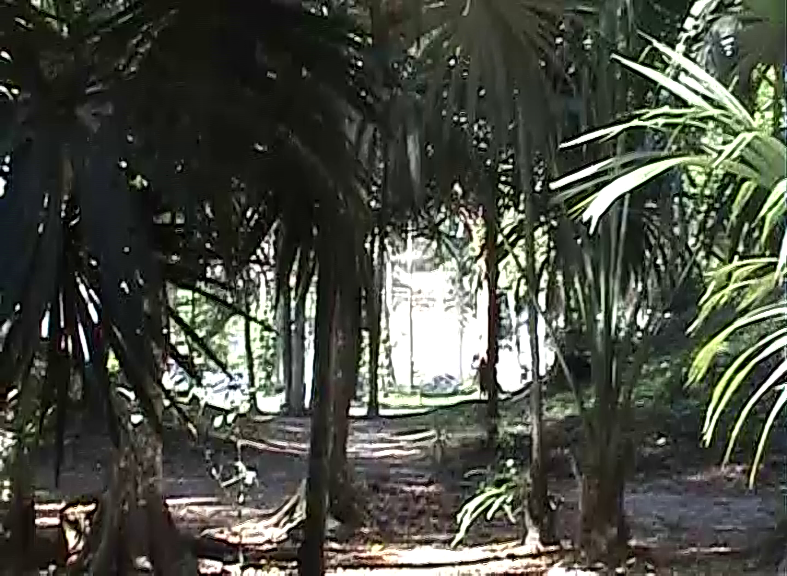 One of the ballcourts mostly covered in vegetation
One of the ballcourts mostly covered in vegetation
And when you walk across the ballcourt, you get to the Plaza of the Seven Temples. The square got this name because on its east side there are seven small temples arranged in a row. The one in the middle is biggest, while on each of its sides there are three smaller ones that are almost identical. At the time I was in Tikal, in May 2008, most of these temples had not been cleared, although the restoration of the middle temple was well on its way. According to what I’ve seen on the internet, a lot has been done in the meantime, but I have no regrets for being here before the completion of the works. Namely, I found it quite impressive to see how the rainforest claimed its position here.
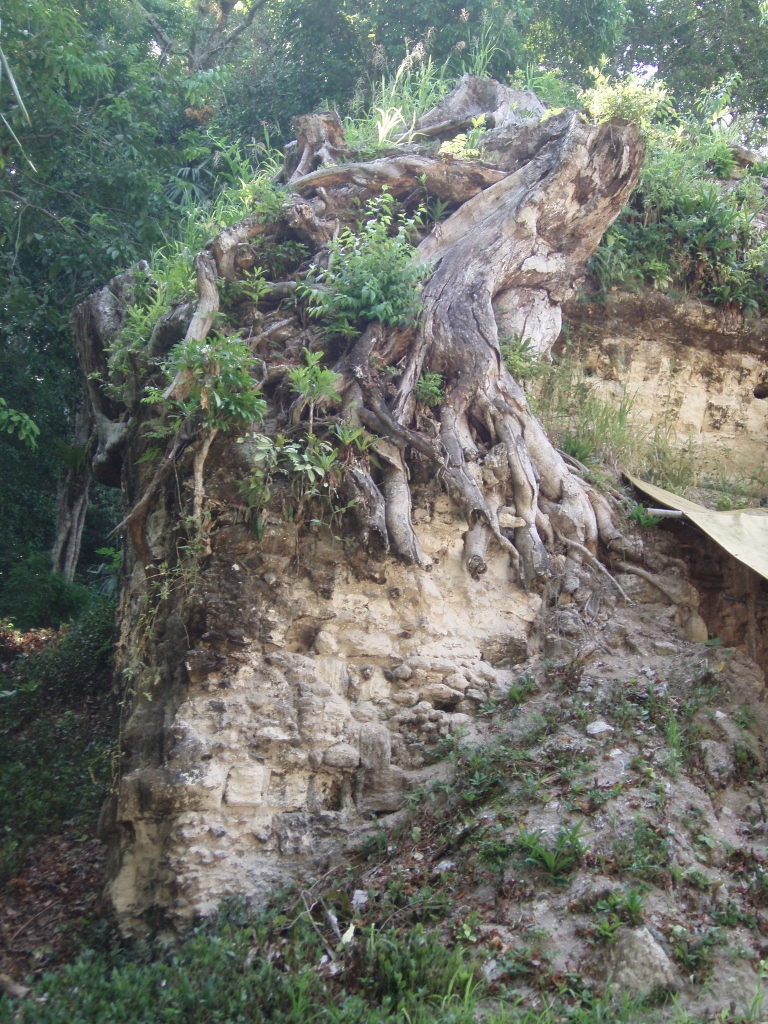 Plaza of the Seven Temples – one of the temples on top of which you can still see the roots of a tree cut down in order to be able to conduct the restoration
Plaza of the Seven Temples – one of the temples on top of which you can still see the roots of a tree cut down in order to be able to conduct the restoration
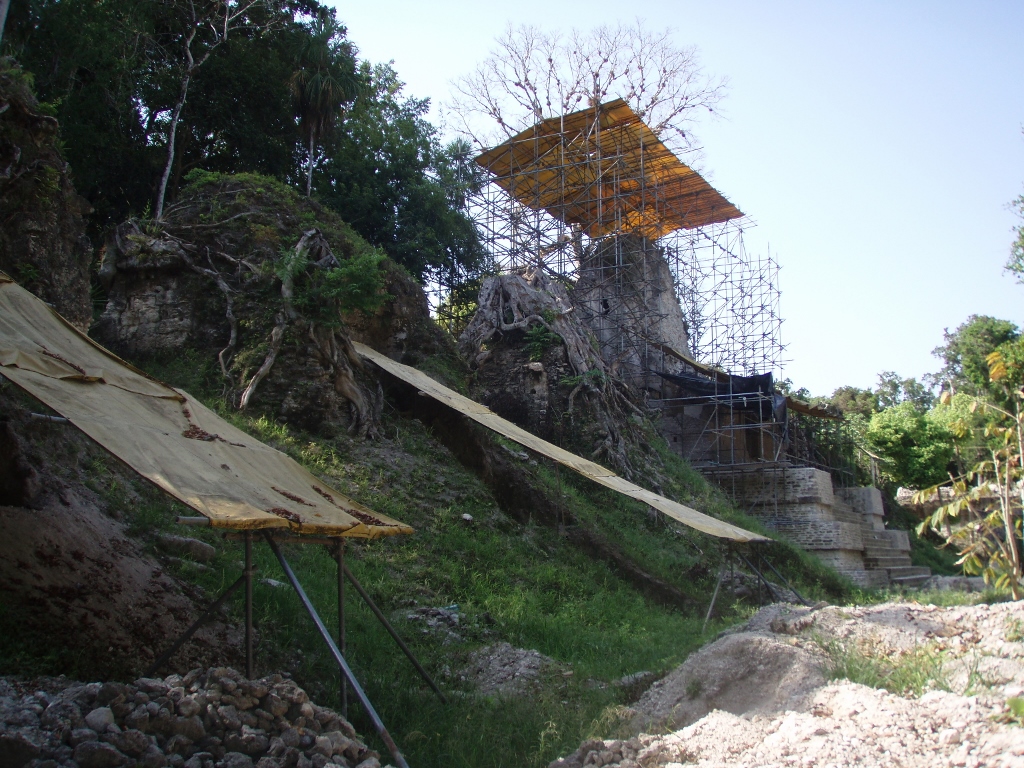 Plaza of the Seven Temples – ongoing restoration works
Plaza of the Seven Temples – ongoing restoration works
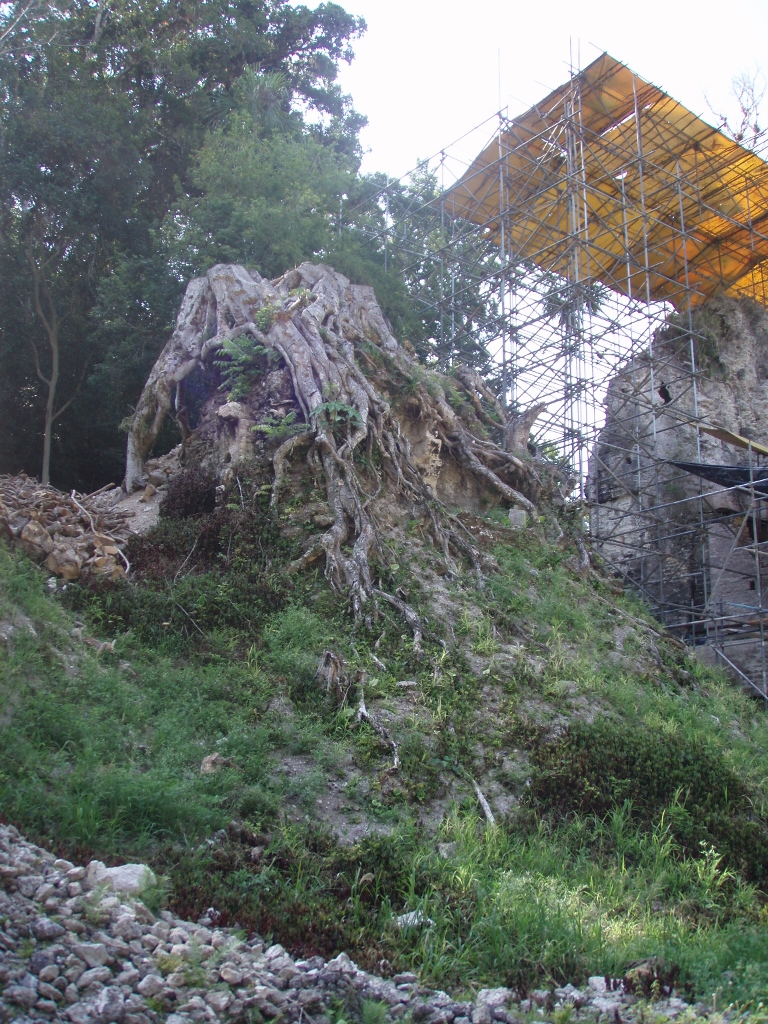 Plaza of the Seven Temples – roots of a tree that still cover the top of a temple
Plaza of the Seven Temples – roots of a tree that still cover the top of a temple
Not all the temples were covered by tree roots, but those that were looked to me like a head covered in strands of long hair.
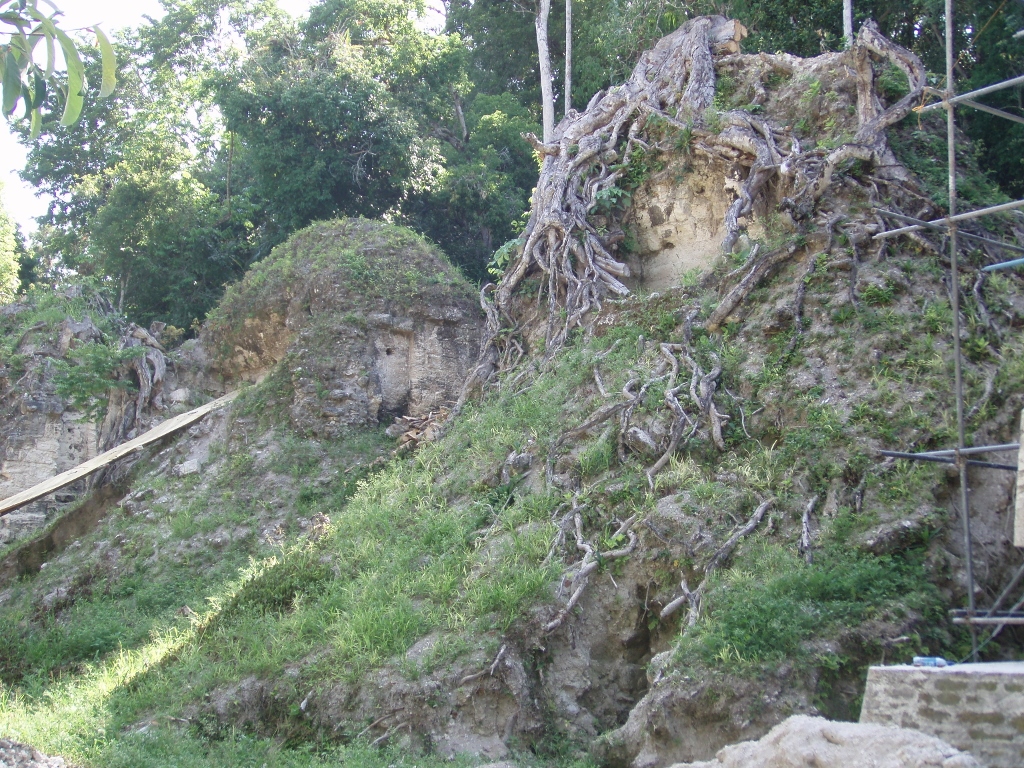 Plaza of the Seven Temples – roots like hair strands covering a mound under which there is a temple
Plaza of the Seven Temples – roots like hair strands covering a mound under which there is a temple
As for the middle temple, as I’ve said, it is the biggest one, 2.5 metres higher than the remaining six, with its restoration well under way back in 2008. It was also covered in tree roots before the restoration and they had actually started to destroy its roof comb, but the roots were removed already in 2004.
In the next photograph, in front of the temple, it is possible to see a semi-dug-in stele above which there is a roof made of reeds.
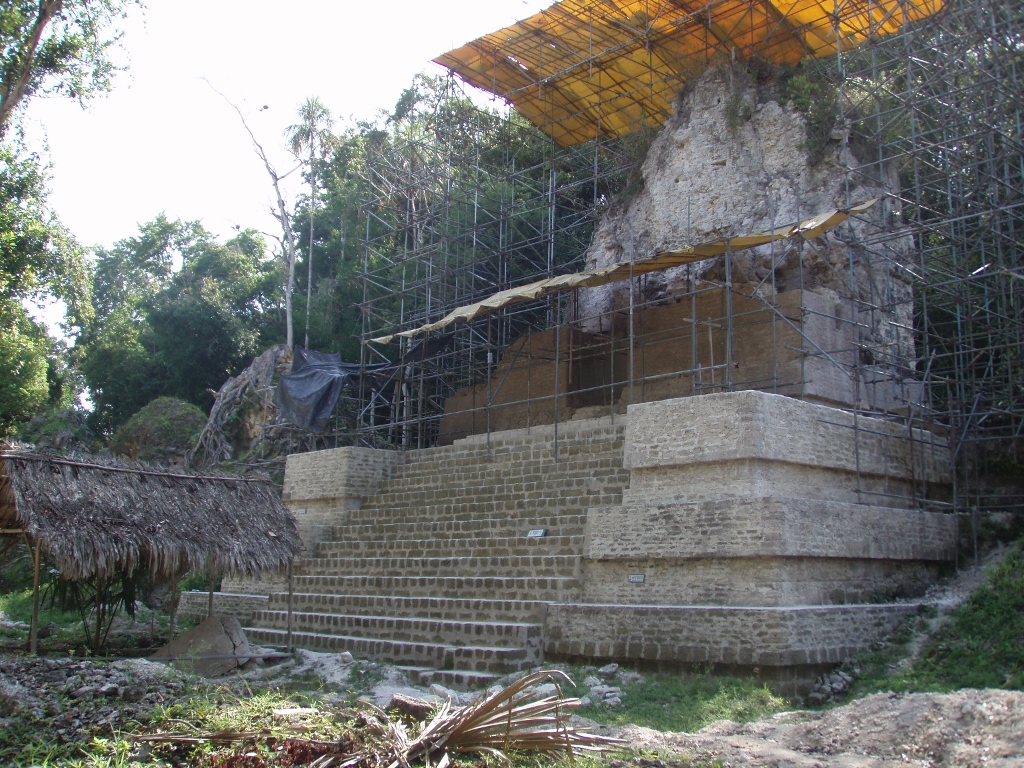 Biggest of the seven temples at the Plaza of the Seven Temples
Biggest of the seven temples at the Plaza of the Seven Temples
In the centre of the photo below, there is that semi-dug-in stele and the pertaining altar, since they usually came in pairs and were traditionally used for sacrifices and offerings.
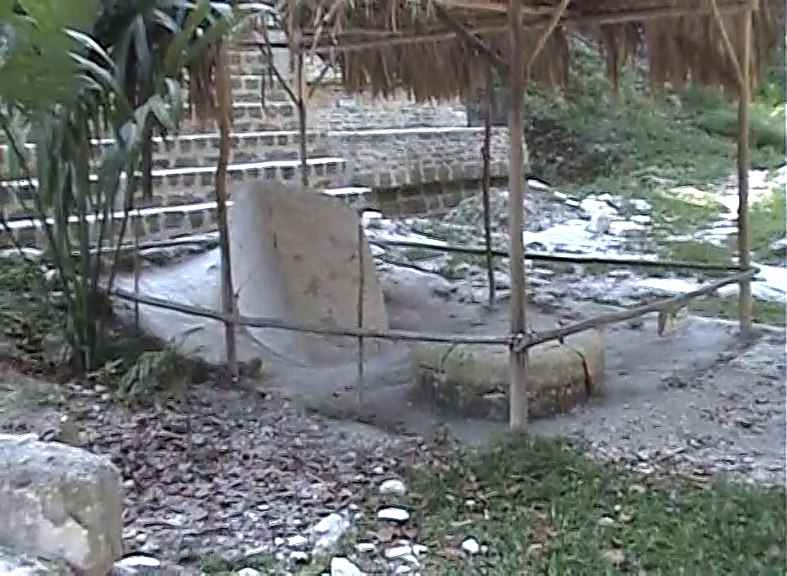 Stele and altar at the Plaza of the Seven Temples
Stele and altar at the Plaza of the Seven Temples
On the south and west sides of the Plaza of the Seven Temples there are different palaces or rather their remains. On the south side there are three of them, with the middle one being the biggest.
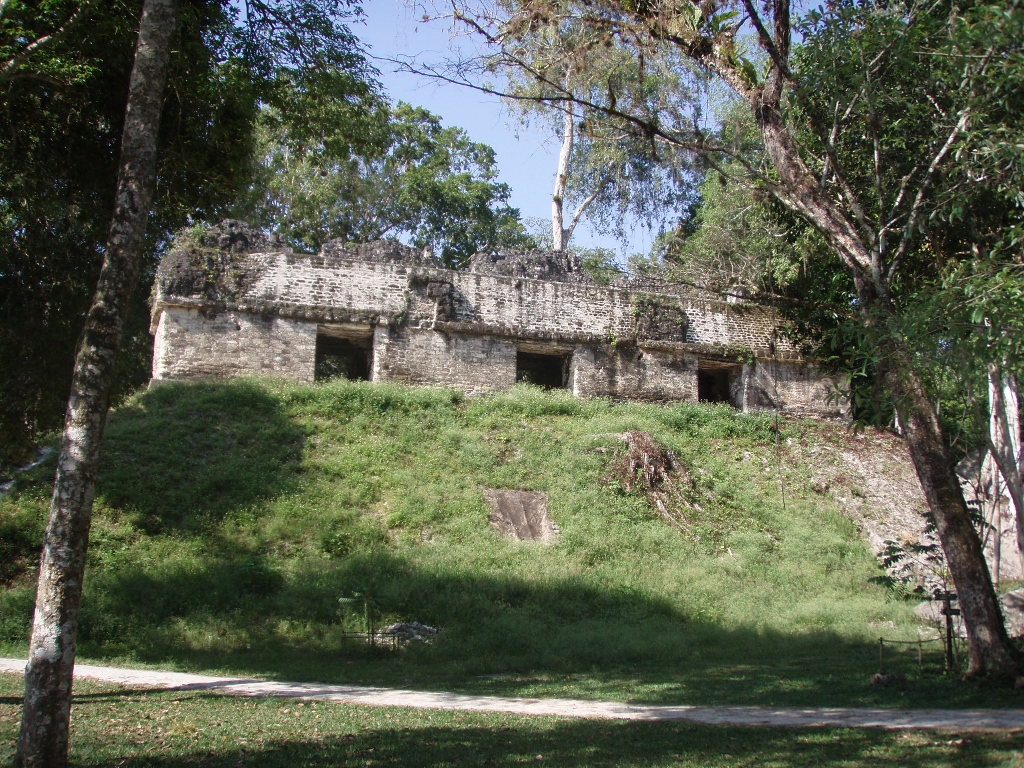 Remains of the middle palace on the south side of the Plaza of the Seven Temples
Remains of the middle palace on the south side of the Plaza of the Seven Temples
On the west side, there is a temple that formally belongs to the Lost World complex, since this complex and the Plaza of the Seven Temples are literally adjacent and they are separated by a number of structures including this Temple of the Skulls (Templo de las Calaveras) named like this on account of some decorations in the shape of skulls. The Temple of the Skulls was also built in a couple of phases and it is the third largest structure within the Lost World complex.
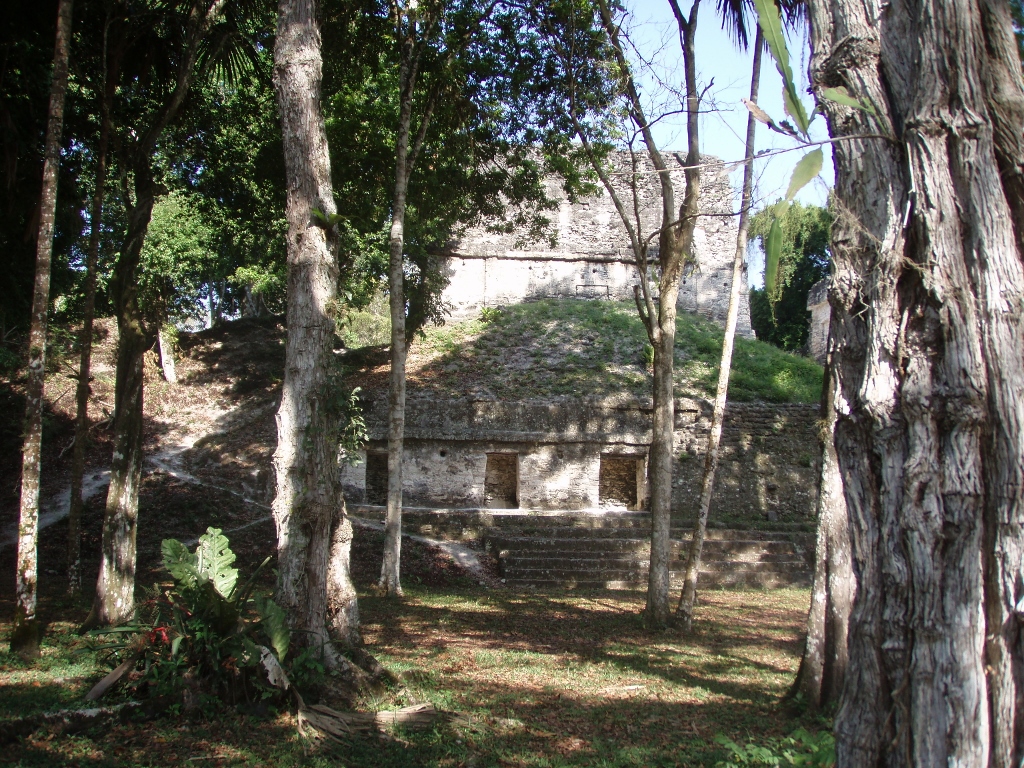 Temple of the Skulls as seen from the Plaza of the Seven Temples
Temple of the Skulls as seen from the Plaza of the Seven Temples
Here at the plaza we also saw a red tree with peeling bark. The guide told us that this reminds the local population of the white people who come here, sunbathe and then get sunburns. The locals must have a field day and laugh a lot at the expense of the whites. And rightfully so. The name of the tree is gumbo-limbo (Bursera simaruba). The guide also said that the tree had medicinal properties. It is possible to bathe in the tea made of leaves and the tea can also be taken against different infections. It is additionally interesting that this is one of the most wind-resistant tree species and so it is recommended to be planted in the areas affected by hurricanes, at least as living fence posts.
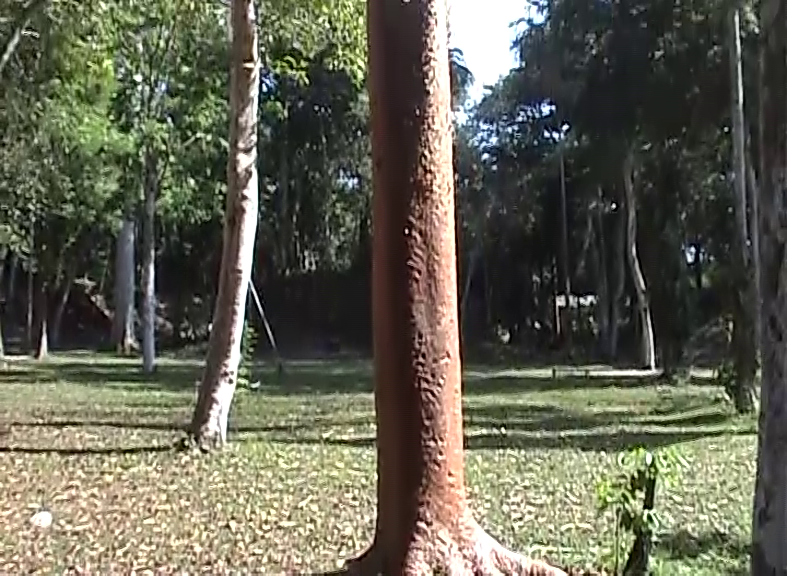 Red trunk of the gumbo-limbo tree
Red trunk of the gumbo-limbo tree
We finished with our visit to the plaza here, so we moved on, passing also by the back sides of the seven temples that the square owes its name to. It seemed that their state was significantly better on this side though.
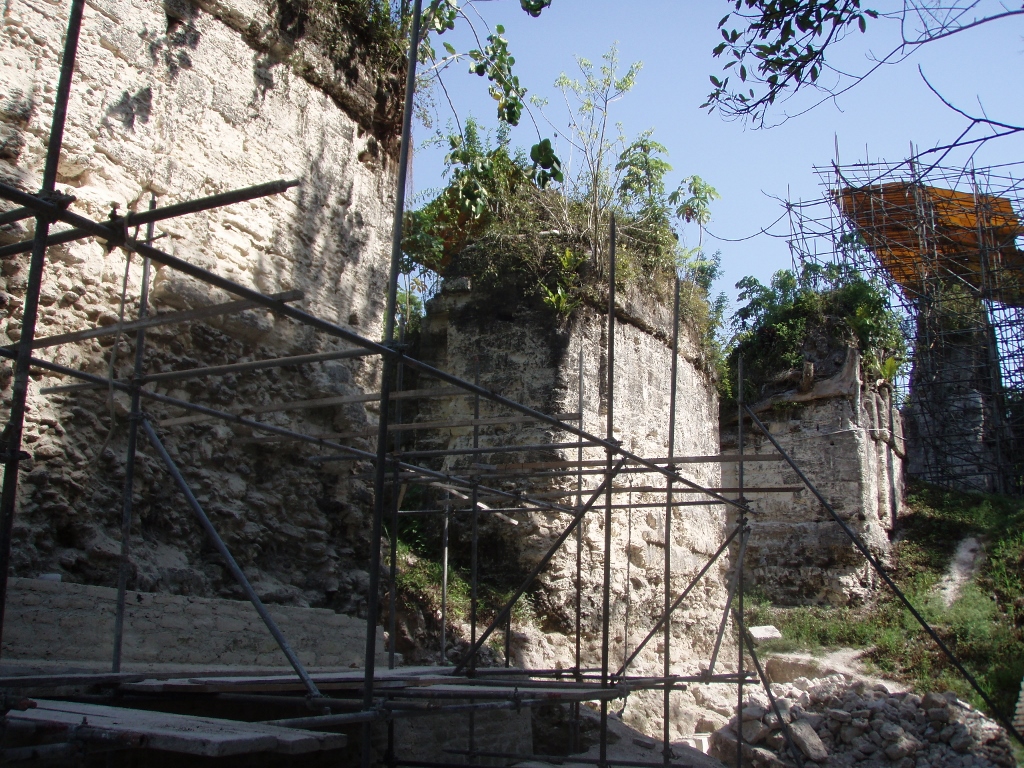 Back sections of the temples from the Plaza of the Seven Temples
Back sections of the temples from the Plaza of the Seven Temples
While moving on, we came across a group of the Geoffroy’s spider monkeys (Ateles geoffroyi) who although letting out strong sounds are not as loud as the Guatemalan or Yucatan black howlers (Alouatta pigra). However, they did not cooperate and would not pose, opting rather to rush and jump through the treetops. There was nothing we could do, so we went on our way and soon we reached Temple V. In fact, we passed along the path on the left-hand side of the temple when looking from its front and then all of a sudden we could see a wide clearing. The impression was completely fantastic. Still, I first went to the right-hand side since I had more space there to take of photo of the entire temple-pyramid.
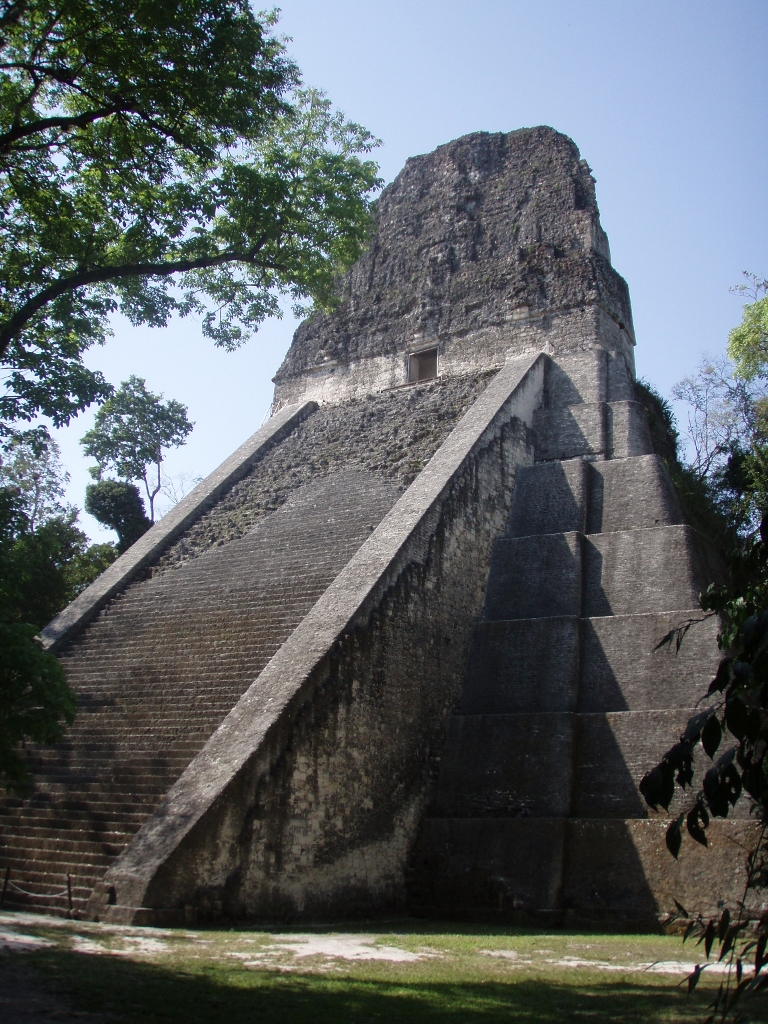 Temple V
Temple V
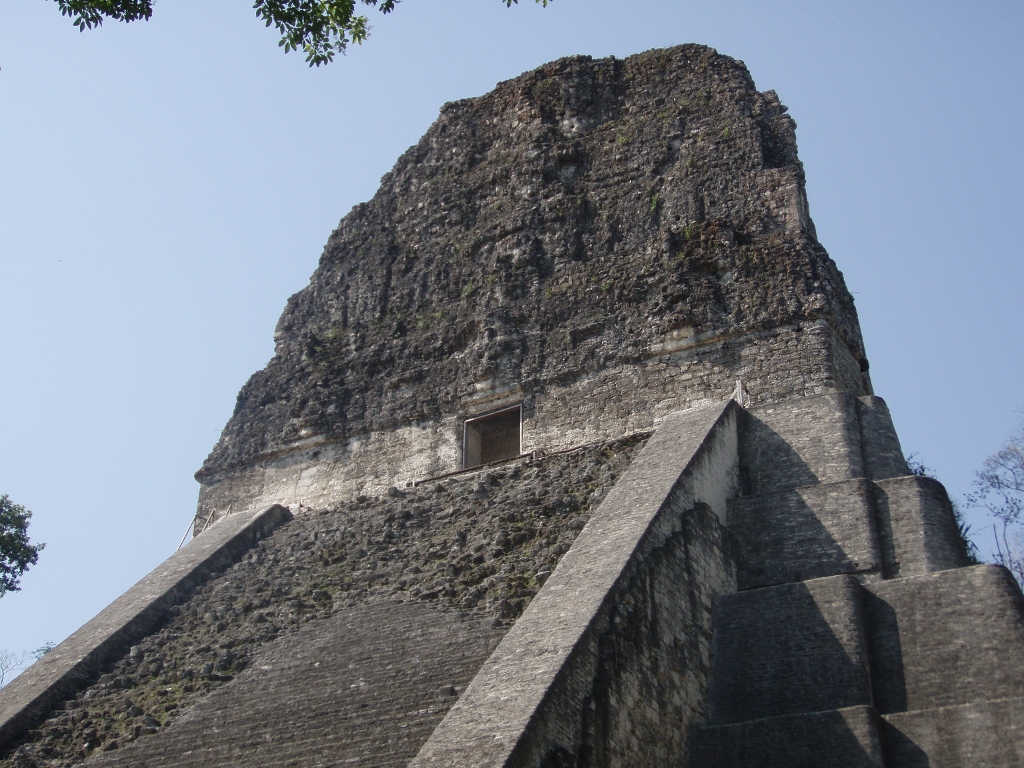 Temple V, view at the shrine o the top of the stairway and the roof comb
Temple V, view at the shrine o the top of the stairway and the roof comb
The construction of this temple started around the middle of the 7th century and it was completed around the year 700 CE. Including the roof comb, it is around 58 m high which makes it the second highest pyramid at the site (after Temple IV). As opposed to the other large temples, the pyramid of Temple V has rounded corners on its terraces, which can be seen in the previous two photos. Also as opposed to the other large temples where the access stairway is either on the east or on the west side, in case of Temple V the stairway is positioned on the north side. Along the stairway, on both sides, there are wide balustrades and it is also interesting that in the shrine on the top there are still original wooden lintels. Both on the shrine and on the roof comb, the researchers have noticed several masks of the rain god Chaac, as well as a couple of masks that symbolise the Mayan god of the Sun.
It is possible to climb up to the shrine of the temple, not using the central stone stairway, but rather the wooden stairs constructed at the side, like large fixed ladders.
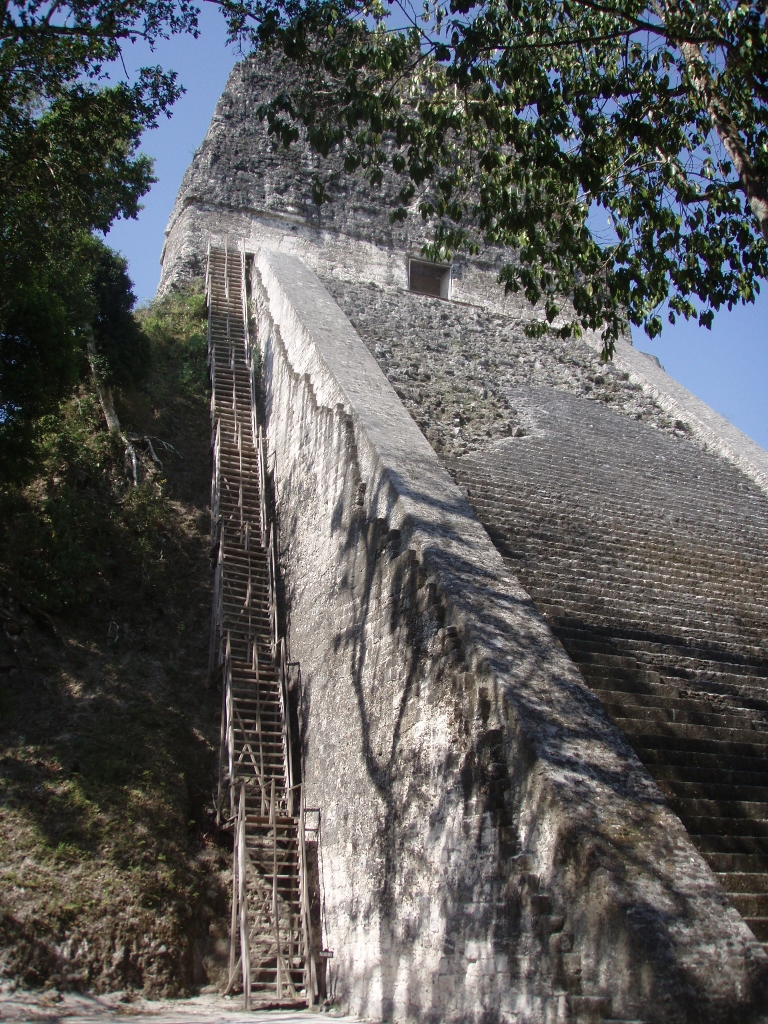 Temple V, stairway on the northeast side
Temple V, stairway on the northeast side
Following my feelings, and they were that I felt hot and lazy, I refused to go up, but Ana went.
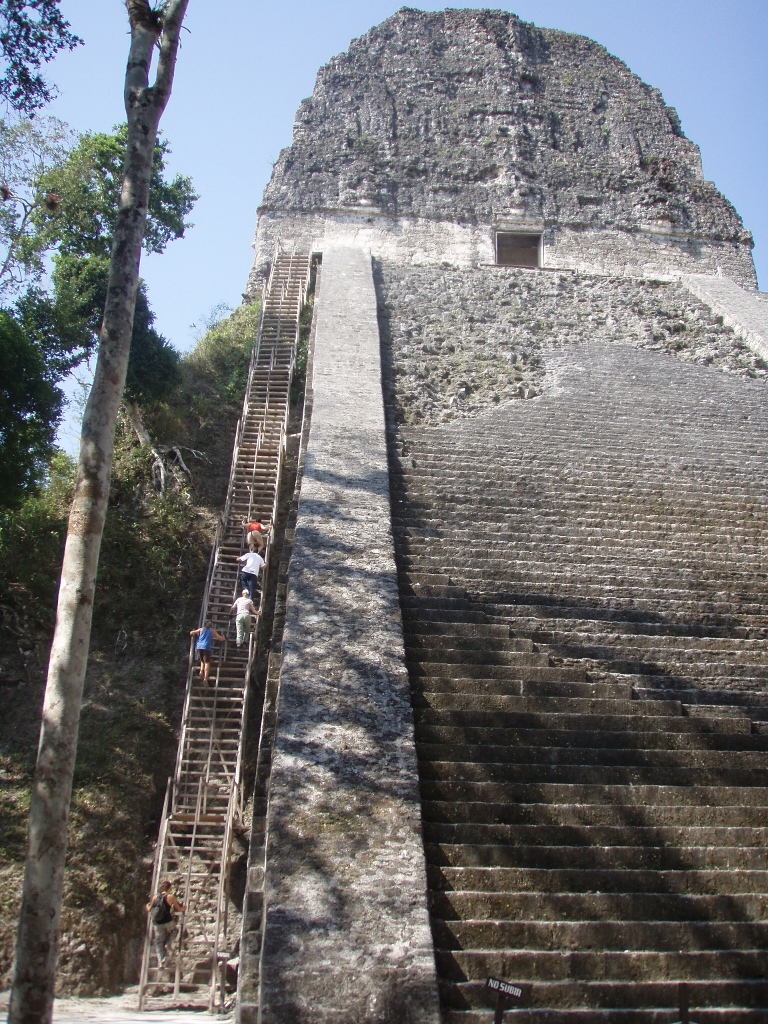 Temple V, bold and industrious visitors are slowly climbing up towards the top
Temple V, bold and industrious visitors are slowly climbing up towards the top
While waiting in the pleasant shade for the part of the group that had gone to the top to return, I took the opportunity and ventured into the forest a little in order to film a group of the Geoffroy’s spider monkeys. The problem was that they moved a lot through the dense tops of the tall trees, but the following short video clip does show them a little.
When I gave up on the further torture trying to film or take photos of the monkeys, I turned around and the impression was truly jaw-dropping. After several minutes of concentrated gaze into the treetops, now in front of me there was the impressive Temple V from the year 700, while on the top of the stairs, by the shrine, I could see a few people from my group who had climbed up there.
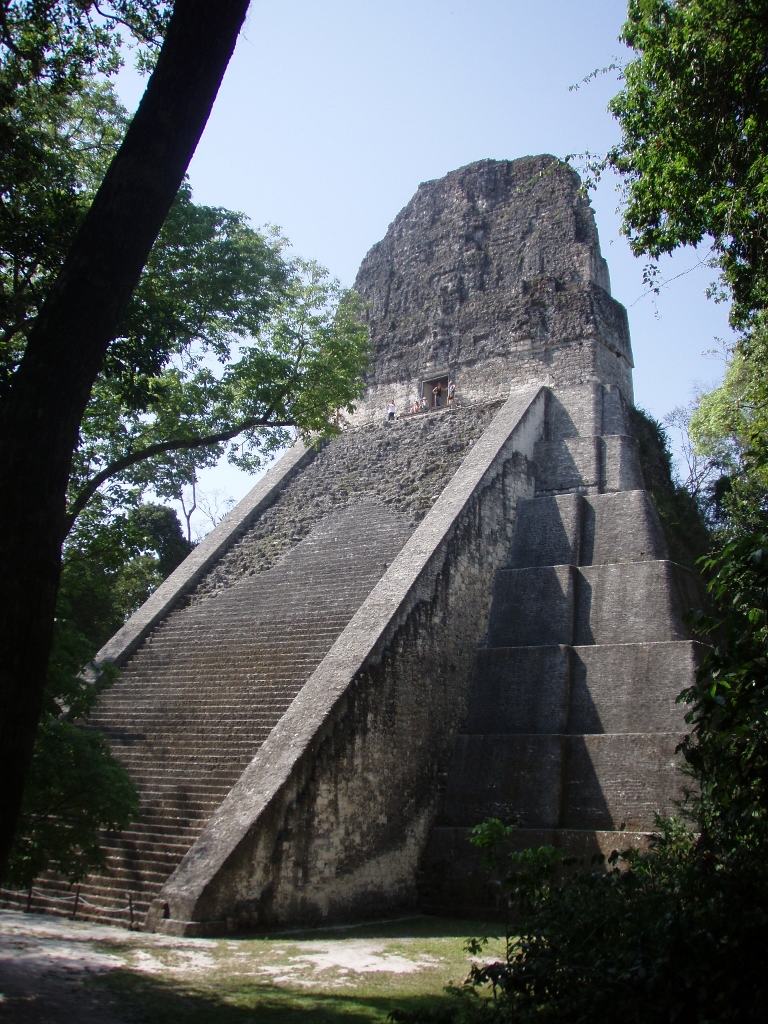 Temple V, there are a few people by the shrine
Temple V, there are a few people by the shrine
While killing time waiting for the return of those that had gone up to the shrine, I also looked more closely at the stairway of the temple. It is prohibited for visitors to climb there and the stairway has been restored up to different degrees, so the experts have probably left it like that in order to be able to see better what the original stairway used to look like, what it is in some semi-phase and how eroded it is towards the top.
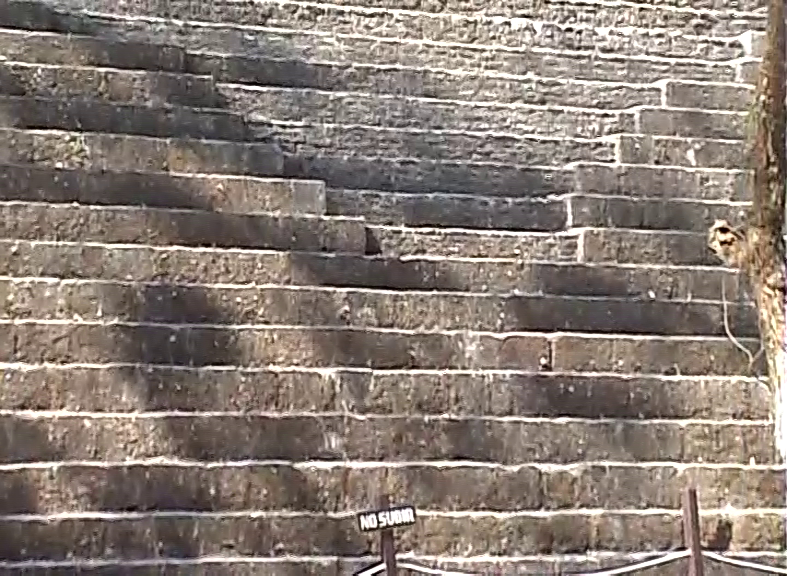 Stairway of Temple V: completely restored stairway at the bottom and the beginning of some “inter-phase”
Stairway of Temple V: completely restored stairway at the bottom and the beginning of some “inter-phase”
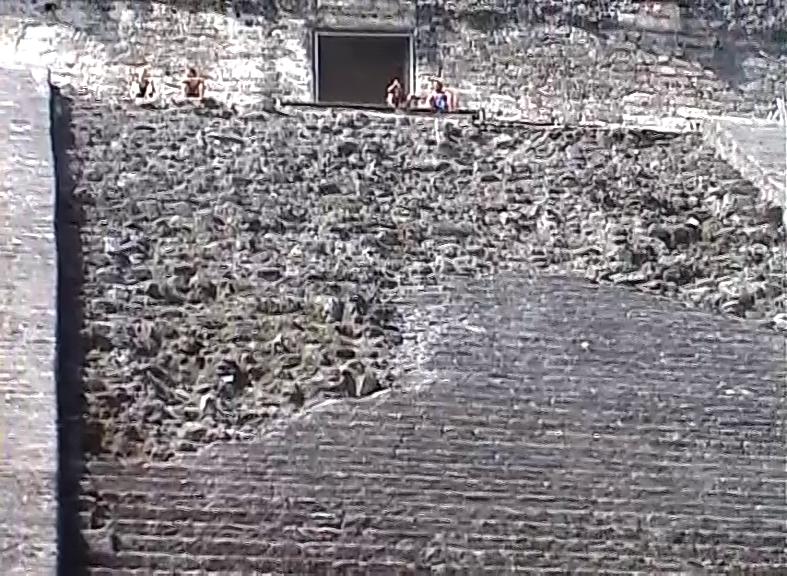 Stairway of Temple V: end of the “inter-phase” and the eroded part towards the top of the stairway
Stairway of Temple V: end of the “inter-phase” and the eroded part towards the top of the stairway
I waited for Ana to come back from the top and then happened the third very important thing for which she was “sent” to my life in these hardly two days that we hanged out and travelled together. This time, thanks to her, I learned one of the most important lessons for travelling. Namely, she came back and said that it was my choice whether I would climb up or not, but that I would make a huge mistake if I didn’t.
You know that nowadays everybody says that we should follow “our feelings.” This has become one of the many frequent platitudes of the 20th and the 21st centuries. Although following one’s feelings constitutes a deeply significant advice, it actually makes sense only in the case of very few people. Most of the human race do know where their head is, let alone what their “feeling” is. My “feeling” here was a very superficial sensation that I was hot and that I did not feel like climbing. In such situations it is actually much better to use reason, that is, the rational part of our being which the advocates of the above-mentioned platitude sneer at. This is utterly wrong and on top of that it is plain stupid. Both feelings and reason have their functions in our lives. The entire civilisation is based precisely on not following our feelings and on rational behaviour. If everybody always followed their feelings, and not their reason, they would all pee and poop right there and then when they “feel” the need for it. Nobody would go to school or become literate (even I, as a proven nerd, did not like to go to school, but once there I wanted to be an excellent student). There is plenty more I could add on the subject, but let me go back to Tikal and to May 2008.
Encouraged by Ana’s comment, for which I am eternally grateful to her, I made a rational decision that, despite my sensation of being hot and not feeling like making any effort, I would climb to the top of Temple V. Although I don’t think that the entire experience and the view from above were spectacular, I am still truly glad I did it. If I hadn’t, I think I would have been very sorry about it today. After all, it is almost certain that this was my only visit to Tikal, so why shouldn’t one do everything that one can. And it was precisely this that constituted that very important lesson for my travels. When travelling, although I do not behave like a programmed robot and I make breaks in order to rest a little, I try indeed to use every single moment to see or visit something and I don’t mind in the least to get up early, to walk faster in order to see a little bit more, to postpone a break or to eat something while I’m walking and visiting instead of sitting down in a restaurant.
So, at this moment I took a rational decision to climb up and so the climbing could start. It was not easy, i.e., it was hot and strenuous, but it was worth it nonetheless.
 View from the top of Temple V: Great Plaza, Temple II (left), North Acropolis (middle) and Temple I (right)
View from the top of Temple V: Great Plaza, Temple II (left), North Acropolis (middle) and Temple I (right)
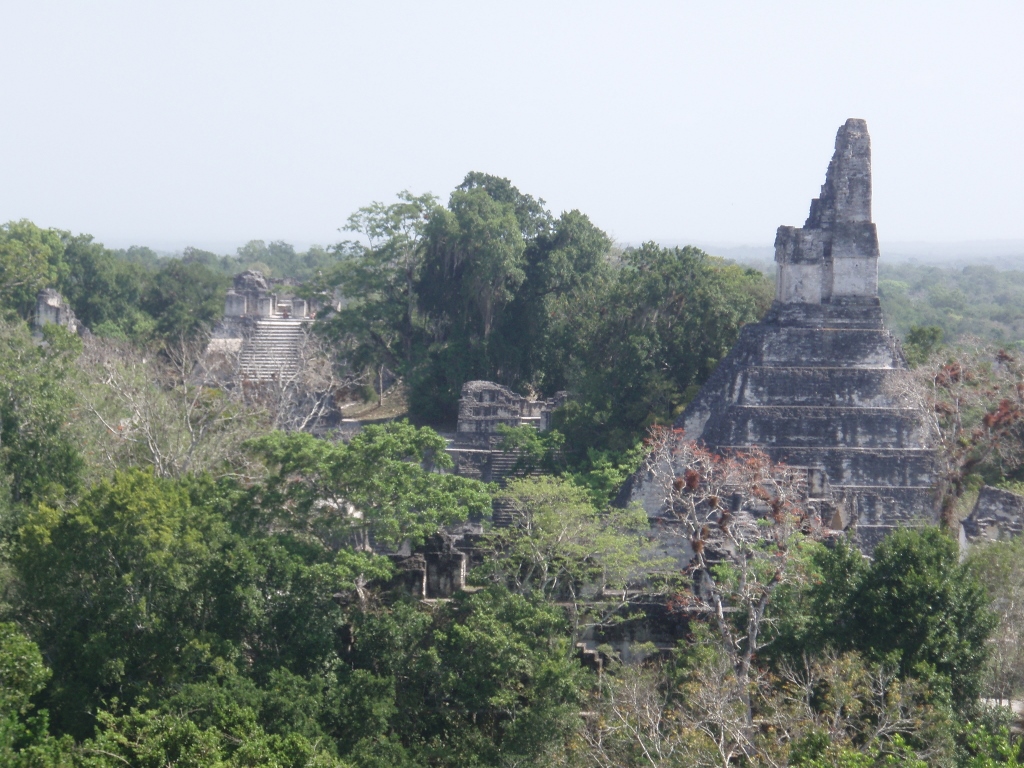 View from the top of Temple V: North Acropolis (left) and Temple I (right)
View from the top of Temple V: North Acropolis (left) and Temple I (right)
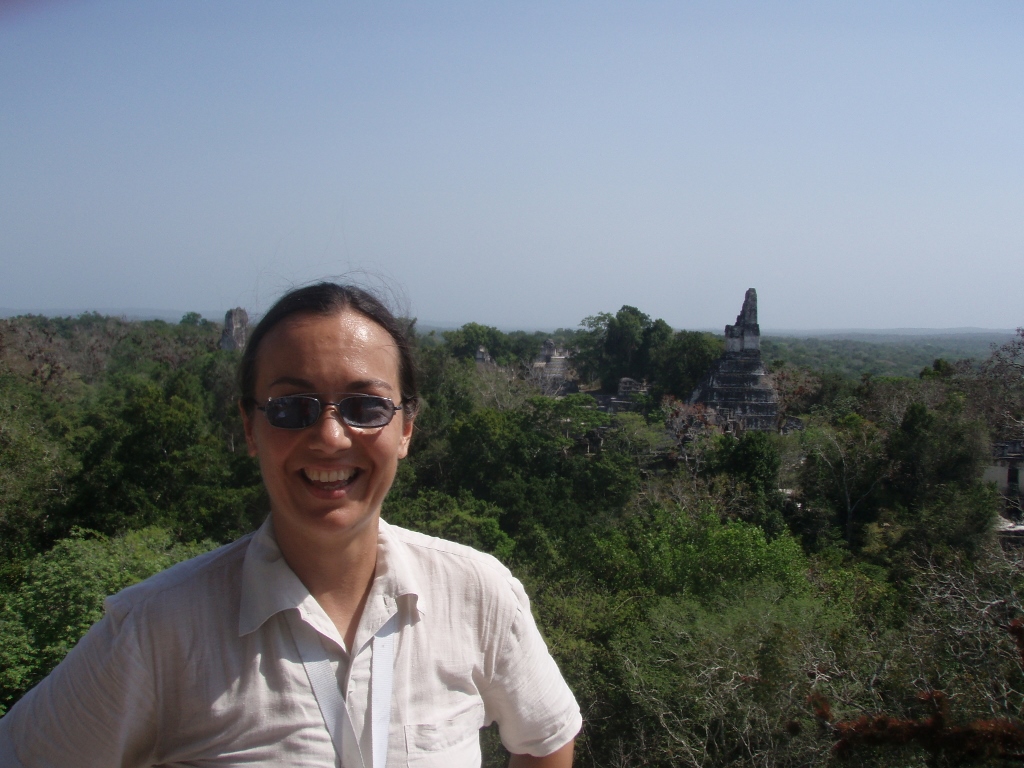 On the top of Temple V
On the top of Temple V